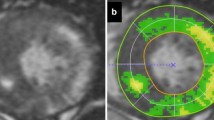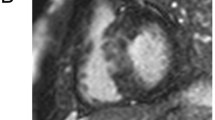Abstract
Early gadolinium enhancement (EGE), one CMR diagnostic criteria in acute myocarditis, has been related with hyperemia and capillary leakage. The value of EGE in hypertrophic cardiomyopathy (HCM) remains unknown. Our aim was to determine the prevalence of EGE in patients with HCM, and its relation with late gadolinium enhancement (LGE). The association of EGE with morphological and clinical parameters was also evaluated. Sixty consecutive patients with HCM and CMR from our center were included. All the clinical and complementary test information was collected prospectively in our HCM clinic. Left ventricular (LV) measurements were calculated from cine sequences. EGE and LGE were quantified with a dedicated software. Clinical events were collected from medical records. A slow wash-out pattern on EGE was detected in up to 68 % of the patients, being an isolated finding without LGE in 10 (16 %). This cohort showed a greater maximal LV wall thickness (20.1 ± 4 vs. 18.1 ± 3.5 mm, p = 0.010) and asymmetry ratio (1.86 ± 0.42 vs. 1.62 ± 0.46; p = 0.039). The percentage of EGE/slice and the difference with the percentage LGE/slice demonstrated a significant positive correlation with the maximal LV wall thickness (Rho 0.450 and 0.386 respectively). EGE also correlated with number of segments with LVH (LV hypertrophy) and the asymmetry ratio. Neither EGE nor LGE were associated with classical risk factors, the risk score for sudden cardiac death, or with major clinical events. EGE was a frequent finding in HCM, even in absence of LGE. This phenomenon showed a positive correlation with morphological markers of disease burden.




Similar content being viewed by others
References
Task FORCE m, Elliott PM, Anastasakis A et al (2014) ESC Guidelines on diagnosis and management of hypertrophic cardiomyopathy: the Task Force for the Diagnosis and Management of Hypertrophic Cardiomyopathy of the European Society of Cardiology (ESC). Eur Heart J 35(39):2733–2779. doi:10.1093/eurheartj/ehu284
Elliott PM, Poloniecki J, Dickie S et al (2000) Sudden death in hypertrophic cardiomyopathy: identification of high risk patients. J Am Coll Cardiol 36(7):2212–2218
Maron BJ (2010) Contemporary insights and strategies for risk stratification and prevention of sudden death in hypertrophic cardiomyopathy. Circulation 121(3):445–456. doi:10.1161/CIRCULATIONAHA.109.878579
Maron BJ, Doerer JJ, Haas TS et al (2009) Sudden deaths in young competitive athletes: analysis of 1866 deaths in the United States, 1980–2006. Circulation 119(8):1085–1092. doi:10.1161/CIRCULATIONAHA.108.804617
Varnava AM, Elliott PM, Mahon N et al (2001) Relation between myocyte disarray and outcome in hypertrophic cardiomyopathy. Am J Cardiol 88(3):275–279
Varnava AM, Elliott PM, Sharma S et al (2000) Hypertrophic cardiomyopathy: the interrelation of disarray, fibrosis, and small vessel disease. Heart 84(5):476–482
Adabag AS, Maron BJ, Appelbaum E et al (2008) Occurrence and frequency of arrhythmias in hypertrophic cardiomyopathy in relation to delayed enhancement on cardiovascular magnetic resonance. J Am Coll Cardiol 51(14):1369–1374. doi:10.1016/j.jacc.2007.11.071
Bruder O, Wagner A, Jensen CJ et al (2010) Myocardial scar visualized by cardiovascular magnetic resonance imaging predicts major adverse events in patients with hypertrophic cardiomyopathy. J Am Coll Cardiol 56(11):875–887. doi:10.1016/j.jacc.2010.05.007
Prinz C, Schwarz M, Ilic I et al (2013) Myocardial fibrosis severity on cardiac magnetic resonance imaging predicts sustained arrhythmic events in hypertrophic cardiomyopathy. Can J Cardiol 29(3):358–363. doi:10.1016/j.cjca.2012.05.004
Ellims AH, Iles LM, Ling LH et al (2012) Diffuse myocardial fibrosis in hypertrophic cardiomyopathy can be identified by cardiovascular magnetic resonance, and is associated with left ventricular diastolic dysfunction. J Cardiovasc Magn Reson 14:76. doi:10.1186/1532-429X-14-76
White SK, Sado DM, Flett AS et al (2012) Characterising the myocardial interstitial space: the clinical relevance of non-invasive imaging. Heart 98(10):773–779. doi:10.1136/heartjnl-2011-301515
Chiribiri A, Leuzzi S, Conte MR et al (2015) Rest perfusion abnormalities in hypertrophic cardiomyopathy: correlation with myocardial fibrosis and risk factors for sudden cardiac death. Clin Radiol 70(5):495–501. doi:10.1016/j.crad.2014.12.018
Hueper K, Zapf A, Skrok J et al (2012) In hypertrophic cardiomyopathy reduction of relative resting myocardial blood flow is related to late enhancement, T2-signal and LV wall thickness. PloS one 7(7):e41974. doi:10.1371/journal.pone.0041974
Petersen SE, Jerosch-Herold M, Hudsmith LE et al (2007) Evidence for microvascular dysfunction in hypertrophic cardiomyopathy: new insights from multiparametric magnetic resonance imaging. Circulation 115(18):2418–2425. doi:10.1161/CIRCULATIONAHA.106.657023
Sipola P, Lauerma K, Husso-Saastamoinen M et al (2003) First-pass MR imaging in the assessment of perfusion impairment in patients with hypertrophic cardiomyopathy and the Asp175Asn mutation of the alpha-tropomyosin gene. Radiology 226(1):129–137. doi:10.1148/radiol.2261011874
Melacini P, Corbetti F, Calore C et al (2008) Cardiovascular magnetic resonance signs of ischemia in hypertrophic cardiomyopathy. Int J Cardiol 128(3):364–373. doi:10.1016/j.ijcard.2007.06.023
Abdel-Aty H, Boye P, Zagrosek A et al (2005) Diagnostic performance of cardiovascular magnetic resonance in patients with suspected acute myocarditis: comparison of different approaches. J Am Coll Cardiol 45(11):1815–1822. doi:10.1016/j.jacc.2004.11.069
Friedrich MG, Strohm O, Schulz-Menger J et al (1998) Contrast media-enhanced magnetic resonance imaging visualizes myocardial changes in the course of viral myocarditis. Circulation 97(18):1802–1809
Casale PN, Devereux RB, Kligfield P et al (1985) Electrocardiographic detection of left ventricular hypertrophy: development and prospective validation of improved criteria. J Am Coll Cardiol 6(3):572–580
Romhilt DW, Estes EH Jr (1968) A point-score system for the ECG diagnosis of left ventricular hypertrophy. Am Heart J 75(6):752–758
Sokolow M, Lyon TP (1949) The ventricular complex in left ventricular hypertrophy as obtained by unipolar precordial and limb leads. Am Heart J 37(2):161–186
Lang RM, Bierig M, Devereux RB et al (2005) Recommendations for chamber quantification: a report from the American Society of Echocardiography’s Guidelines and Standards Committee and the Chamber Quantification Writing Group, developed in conjunction with the European Association of Echocardiography, a branch of the European Society of Cardiology. J Am Soc Echocardiogr 18(12):1440–1463. doi:10.1016/j.echo.2005.10.005
Ho CY (2009) Hypertrophic cardiomyopathy: preclinical and early phenotype. J Cardiovasc Transl Res 2(4):462–70. doi:10.1007/s12265-009-9124-7
Friedrich MG, Sechtem U, Schulz-Menger J et al (2009) Cardiovascular magnetic resonance in myocarditis: a JACC White Paper. J Am Coll Cardiol 53(17):1475–1487. doi:10.1016/j.jacc.2009.02.007
O’Donnell DH, Abbara S, Chaithiraphan V et al (2012) Cardiac MR imaging of nonischemic cardiomyopathies: imaging protocols and spectra of appearances. Radiology 262(2):403–422. doi:10.1148/radiol.11100284
Todiere G, Aquaro GD, Piaggi P et al (2012) Progression of myocardial fibrosis assessed with cardiac magnetic resonance in hypertrophic cardiomyopathy. J Am Coll Cardiol 60(10):922–929. doi:10.1016/j.jacc.2012.03.076
Dass S, Suttie JJ, Piechnik SK et al (2012) Myocardial tissue characterization using magnetic resonance noncontrast t1 mapping in hypertrophic and dilated cardiomyopathy. Circ Cardiovasc Imaging 5(6):726–733. doi:10.1161/CIRCIMAGING.112.976738
Rudolph A, Abdel-Aty H, Bohl S et al (2009) Noninvasive detection of fibrosis applying contrast-enhanced cardiac magnetic resonance in different forms of left ventricular hypertrophy relation to remodeling. J Am Coll Cardiol 53(3):284–291. doi:10.1016/j.jacc.2008.08.064
Chan RH, Maron BJ, Olivotto I et al (2014) Prognostic value of quantitative contrast-enhanced cardiovascular magnetic resonance for the evaluation of sudden death risk in patients with hypertrophic cardiomyopathy. Circulation 130(6):484–495. doi:10.1161/CIRCULATIONAHA.113.007094
Kachenoura N, Besson-Hajji L, Graves MJ et al (2015) Kinetic index combining native and postcontrast myocardial T1 in hypertrophic cardiomyopathy. J Magn Reson Imaging. doi:10.1002/jmri.24947
Ismail TF, Jabbour A, Gulati A et al (2014) Role of late gadolinium enhancement cardiovascular magnetic resonance in the risk stratification of hypertrophic cardiomyopathy. Heart 100(23):1851–1858. doi:10.1136/heartjnl-2013-305471
McKenna WJ, Nagueh SF (2014) Cardiac magnetic resonance imaging and sudden death risk in patients with hypertrophic cardiomyopathy. Circulation 130(6):455–457. doi:10.1161/CIRCULATIONAHA.114.010977
Salerno M, Kramer CM (2013) Advances in parametric mapping with CMR imaging. JACC Cardiovasc Imaging 6(7):806–822. doi:10.1016/j.jcmg.2013.05.005
Taylor AJ, Salerno M, Dharmakumar R et al (2016) T1 mapping: basic techniques and clinical applications. JACC Cardiovasc Imaging 9(1):67–81. doi:10.1016/j.jcmg.2015.11.005
Swoboda PP, McDiarmid AK, Erhayiem B et al (2016) Assessing myocardial extracellular volume by T1 mapping to distinguish hypertrophic cardiomyopathy from athlete’s heart. J Am Coll Cardiol 67(18):2189–2190. doi:10.1016/j.jacc.2016.02.054
Mc LA, Ellims AH, Prabhu S et al (2016) Diffuse ventricular fibrosis on cardiac magnetic resonance imaging associates with ventricular tachycardia in patients with hypertrophic cardiomyopathy. J Cardivasc Electrophysiol 27(5):571–580. doi:10.1111/jce.12948
Kellman P, Hansen MS (2014) T1-mapping in the heart: accuracy and precision. J Cardiovasc Magn Reson 16:2. doi:10.1186/1532-429X-16-2
Acknowledgments
This work was partially supported by Spanish Society of Cardiology through a grant for the project “Utility of new morphological and tissue characterization patterns determined by cardiac magnetic resonance in the prognostic evaluation of patients with hypertrophic cardiomyopathy” (“Utilidad de nuevos patrones morfológicos y de caracterización tisular medidos por resonancia magnética cardiaca en la valoración pronóstica de los pacientes con miocardiopatia hipertrófica”).
Author information
Authors and Affiliations
Corresponding author
Ethics declarations
Conflict of interest
No conflict of interest have to be declared.
Additional information
Eduardo Pozo and Dafne Viliani have contributed equally to this study.
Rights and permissions
About this article
Cite this article
Pozo, E., Viliani, D., Aguirre, N. et al. Early gadolinium enhancement in hypertrophic cardiomyopathy: a potential premature marker of myocardial damage. Int J Cardiovasc Imaging 32, 1635–1643 (2016). https://doi.org/10.1007/s10554-016-0954-5
Received:
Accepted:
Published:
Issue Date:
DOI: https://doi.org/10.1007/s10554-016-0954-5




